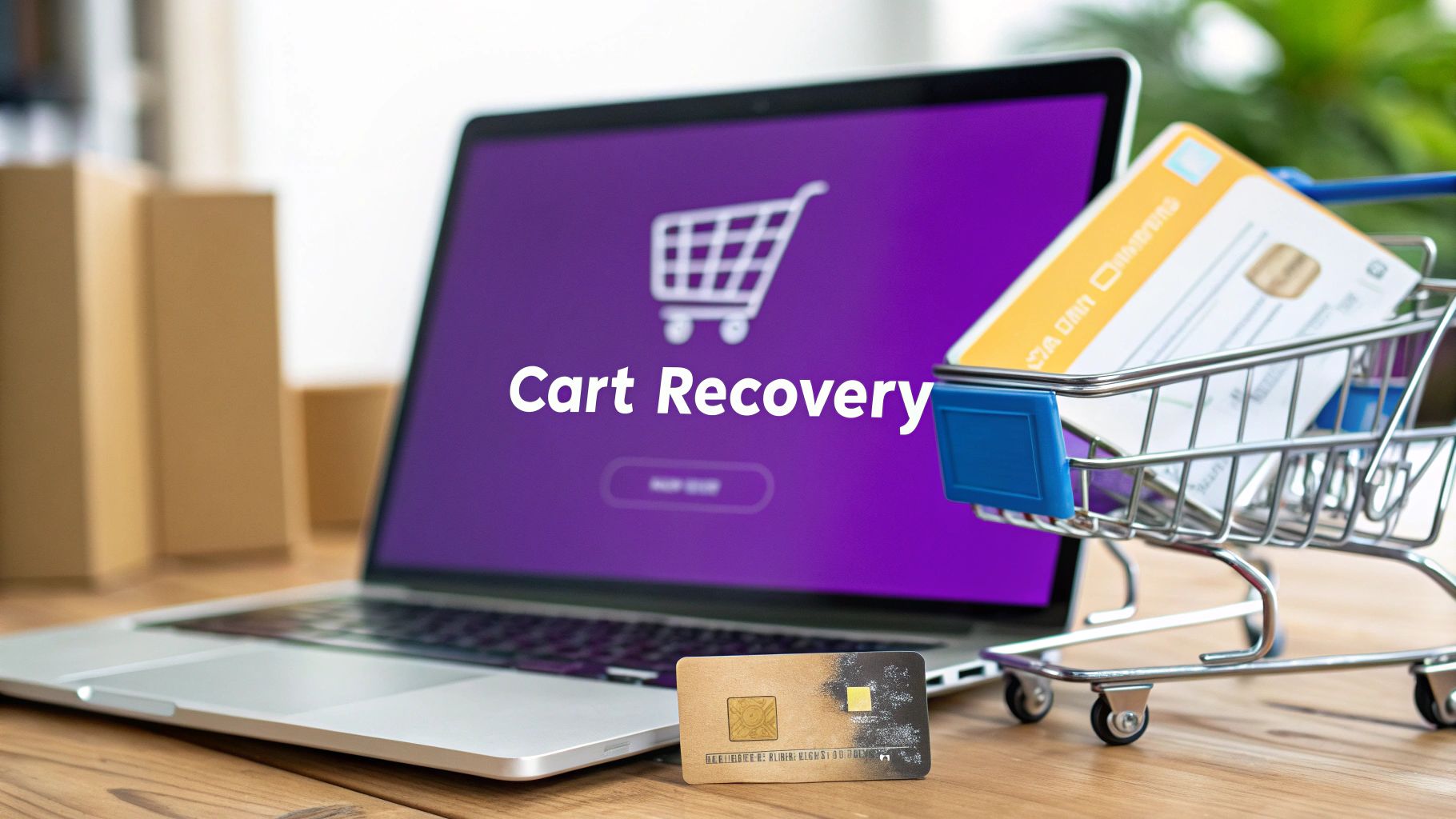7 Powerful Shopping Cart Abandonment Solutions for 2025
It's a frustrating reality for every ecommerce store: a customer finds a product they love, adds it to their cart, and then vanishes without a trace. This isn't just a minor hiccup; it's a multi-trillion dollar issue known as cart abandonment. Studies show that nearly 70% of online shopping carts are abandoned, representing a massive pool of lost revenue that directly impacts your bottom line.
The reasons are diverse, ranging from unexpected shipping costs and a complicated checkout process to simple distraction or second thoughts. But what if you could reclaim a significant portion of that lost potential? The key isn't just understanding why shoppers leave, but implementing powerful shopping cart abandonment solutions designed to bring them back and prevent them from leaving in the first place. This is where the right tools and strategies make all the difference, transforming near-misses into confirmed sales.
This guide moves beyond generic advice to provide a detailed roundup of the most effective platforms and techniques to combat cart abandonment. We will walk you through seven proven solutions, from comprehensive life cycle marketing strategies to specialized apps like Klaviyo and OptinMonster. For each option, we'll provide actionable insights, clear screenshots, and direct links to help you decide which tool best fits your business needs. Our goal is to give you a clear roadmap to not only recover lost sales but also to optimize your entire checkout experience for maximum conversions, turning abandoned carts into a reliable revenue stream.
1. Life Cycle Marketing by Rebus
For businesses seeking a comprehensive and strategic partner rather than just a single-point tool, Rebus's Life Cycle Marketing service presents a formidable solution. This approach fundamentally reframes shopping cart abandonment not as an isolated problem but as a symptom of a disconnected customer journey. Instead of simply sending a "You left something behind" email, Rebus focuses on building a resilient, end-to-end customer relationship that preemptively reduces abandonment and effectively recovers sales when it does happen.
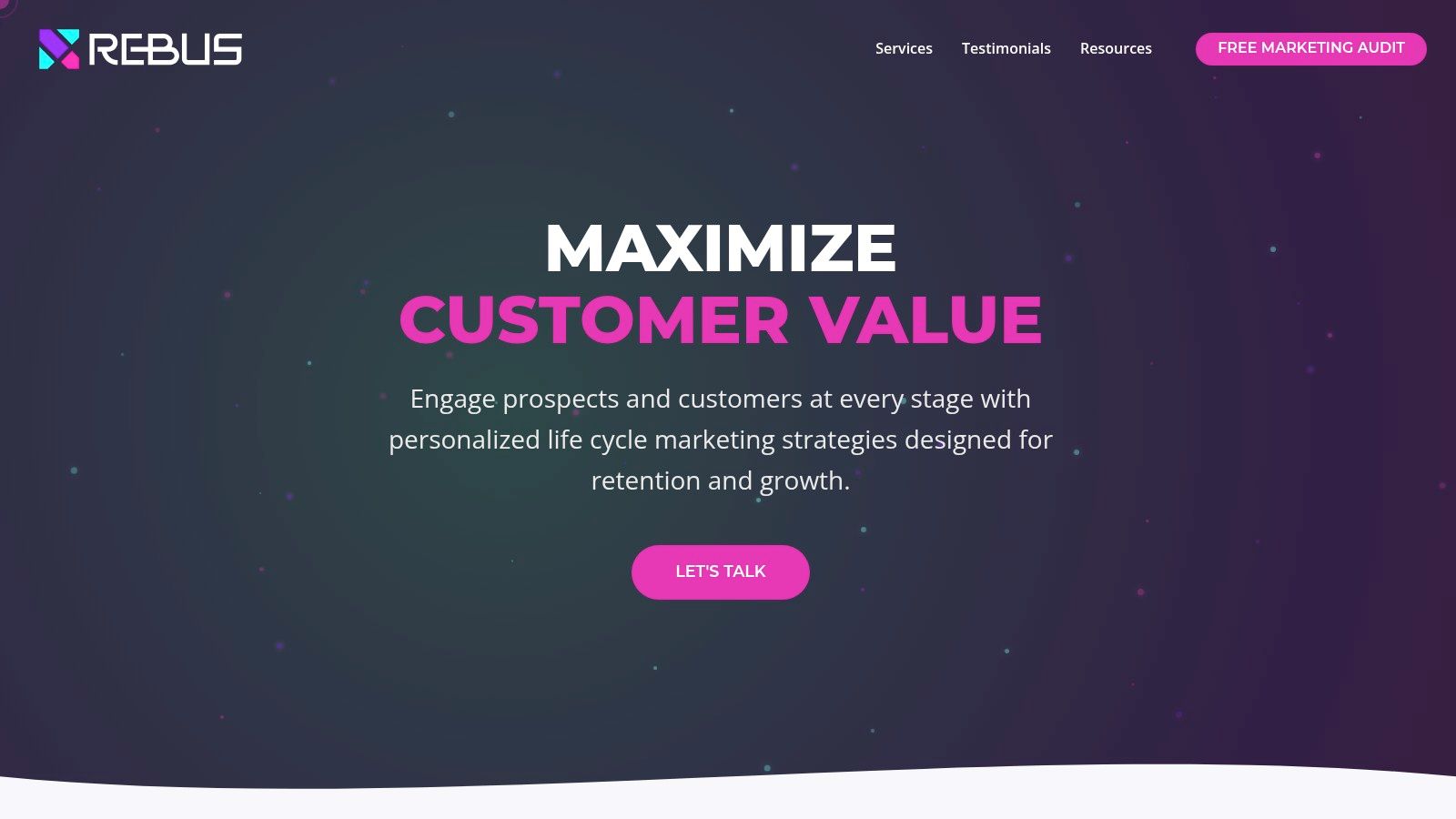
What sets this service apart is its holistic integration of deep market research, creative strategy, and continuous data-driven optimization. It addresses every stage, from attracting a new visitor to nurturing them into a loyal, repeat customer. This is a departure from many standalone shopping cart abandonment solutions that only activate after a sale is already lost.
Key Strengths and Strategic Advantages
Rebus leverages its 14 years of digital marketing expertise to build a robust framework tailored to each client. Their proven three-step process (Define & Strategize, Bring Ideas to Life, and Measure & Optimize) ensures that every action is intentional and aligned with broader business goals.
- Comprehensive Journey Mapping: The service begins by mapping the entire customer lifecycle, identifying potential friction points long before the checkout page. This includes optimizing initial brand touchpoints through SEO and paid social, ensuring a smooth transition from awareness to consideration.
- Data-Driven Personalization: Campaigns are not static. Rebus continuously analyzes customer behavior to deliver personalized, targeted messaging that evolves with user preferences, ensuring communications remain relevant and effective.
- Integrated Service Ecosystem: A significant advantage is the integration with Rebus's other core services, including paid search, SEO, and eCommerce optimization. This creates a powerful synergy where insights from one channel inform and enhance the strategy in another, maximizing overall impact.
Effective Life Cycle Marketing is inherently tied to leveraging automation to nurture customer relationships and recover lost sales. To truly understand the power of these systems, explore the full advantages of marketing automation and how they can transform your engagement strategy.
Practical Application for Cart Recovery
In the context of cart abandonment, Rebus's approach translates into a multi-layered recovery strategy. Instead of a single, generic email, a customer might receive a carefully orchestrated sequence of communications across different channels.
For example, the sequence could include:
An immediate, helpful email reminder focusing on customer service, perhaps asking if they encountered a technical issue.
A follow-up SMS message 24 hours later with a subtle nudge or a limited-time offer to create urgency.
A targeted retargeting ad on social media showcasing the abandoned product and highlighting its key benefits or positive reviews.
This multi-channel, personalized approach goes far beyond standard cart recovery tactics, treating each abandoned cart as an opportunity to strengthen the customer relationship.
| Holistic Strategy | Addresses the entire customer journey, not just the point of abandonment. | Builds trust and reduces friction, leading to lower initial abandonment rates. |
|---|---|---|
| Multi-Channel Nurturing | Utilizes email, paid ads, SEO, and social media to re-engage users. | Increases the chances of recovery by reaching customers on their preferred platforms. |
| Continuous Optimization | Leverages data analytics to refine campaigns and improve performance over time. | Ensures recovery strategies adapt to changing customer behaviors for sustained success. |
| Expert Agency Support | Provides access to a full team of digital marketing professionals. | Delivers a high level of strategic execution without requiring an in-house team. |
Pros and Cons
Pros:
- Comprehensive approach that addresses every stage of the customer journey.
- Backed by 14 years of expertise and over $100 million in managed ad spend.
- Integrated with complementary digital services for maximum impact.
- Data-driven campaigns are continuously optimized for performance.
- Dedicated agency support combines creative vision with rigorous analytics.
Cons:
- Lack of publicly available granular details on specific tactics may require direct consultation.
- Best suited for businesses seeking an integrated digital marketing partner, not a standalone tool.
Learn more at the Rebus Advertising website.
2. Shopify – Abandoned Checkout Recovery (built-in) + App Store
For e-commerce businesses built on the Shopify platform, one of the most accessible and effective shopping cart abandonment solutions is already integrated directly into the system. Shopify's native Abandoned Checkout Recovery feature provides a streamlined way to automatically follow up with potential customers who leave items in their cart, making it an essential first line of defense against lost sales. This built-in functionality is a major advantage for merchants, as it eliminates the need for complex third-party integrations for basic email recovery.
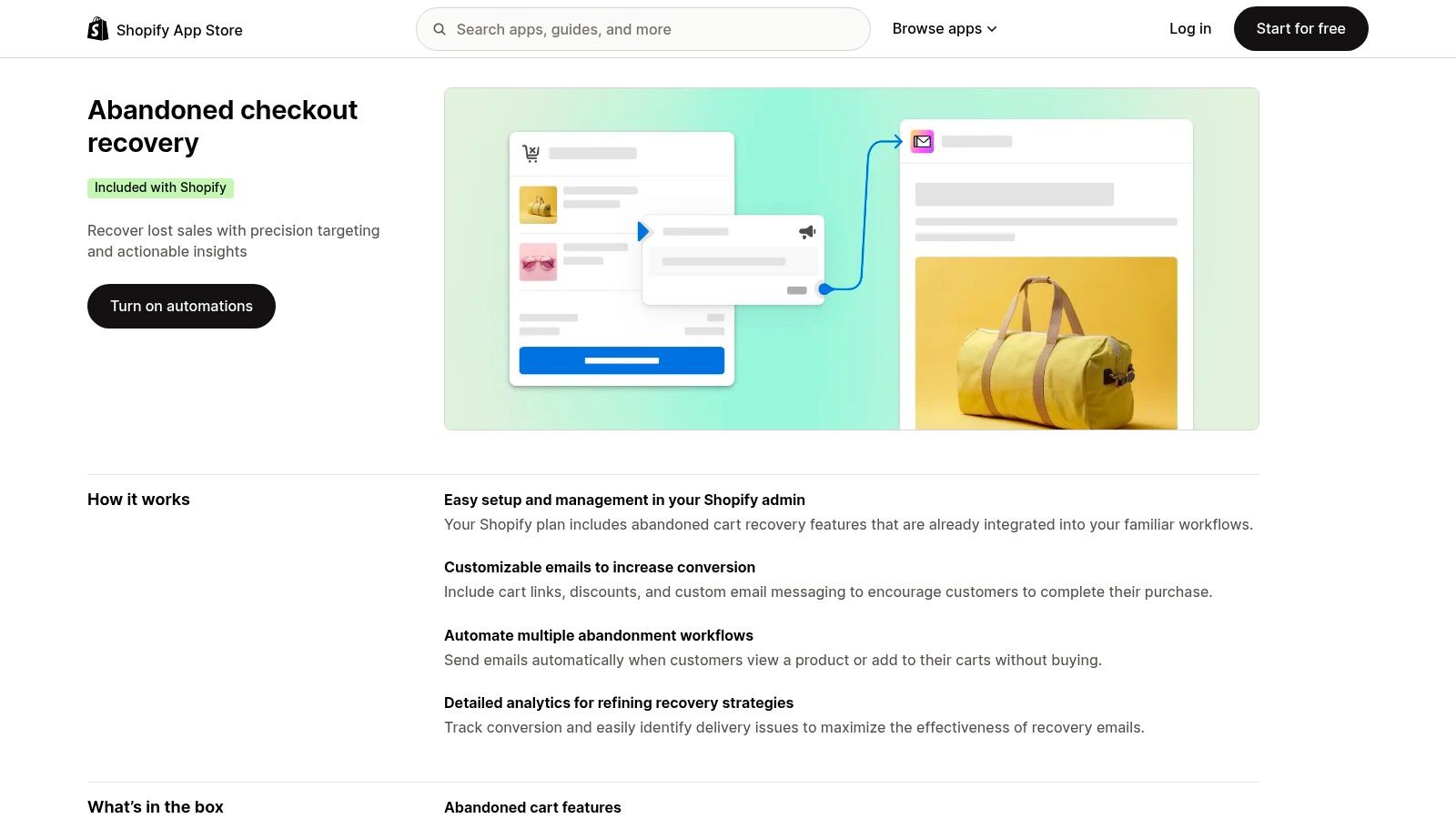
The primary strength of Shopify’s tool lies in its simplicity and direct integration. From the admin dashboard, store owners can activate automated emails that are sent to shoppers a set number of hours after they abandon a checkout. These emails include a direct link back to their pre-filled cart, significantly reducing friction and making it easy for them to complete their purchase.
Key Features and Capabilities
Shopify's offering is a two-pronged approach: a powerful native tool combined with a vast ecosystem of apps. This combination allows businesses to start simple and scale their recovery efforts as they grow.
- Built-in Email Automation: Activate one-click automations from the admin panel. You can customize the email template to match your brand's voice and even include discount codes to incentivize completion.
- Integrated Analytics: The platform provides clear reporting on how many emails were sent, delivered, and how much revenue was recovered. This data is crucial for measuring the ROI of your recovery efforts.
- Vast App Store: While the native tool is email-only, the Shopify App Store is a treasure trove of advanced shopping cart abandonment solutions. You can find highly-rated apps to add SMS reminders, web push notifications, exit-intent popups, and multi-channel sequencing to your strategy.
Pros and Cons
| Seamless Integration: No extra software or setup is needed to start recovering carts via email. | Native Tool is Email-Only: More advanced channels like SMS require third-party apps. |
|---|---|
| Cost-Effective: The basic recovery feature is included in all Shopify plans. | Limited to Online Store: Does not cover abandoned carts from POS or other sales channels. |
| User-Friendly: The interface is intuitive, making it easy for non-technical users to manage. | Customization Can Be Limited: Advanced logic and segmentation may require a more powerful app. |
This built-in feature is a perfect starting point for any Shopify merchant. To learn more about how to integrate this tool into a broader sales funnel, you can explore a variety of marketing strategies for e-commerce. For those needing more advanced functionality, the ability to layer on specialized apps makes Shopify's ecosystem a truly comprehensive solution.
Website: https://apps.shopify.com/built-in-features/abandoned-checkout-recovery
3. BigCommerce – Abandoned Cart Saver (native)
For merchants operating on the BigCommerce platform, a powerful, built-in tool is available right out of the box to combat lost sales. The BigCommerce Abandoned Cart Saver is a native feature designed to automatically re-engage shoppers who add items to their cart but leave without making a purchase. This integrated functionality serves as a crucial component of any e-commerce strategy, providing an immediate way to recover potential revenue without needing external software.
The core advantage of the Abandoned Cart Saver is its seamless integration and ease of use. Directly from the BigCommerce control panel, store owners can set up and customize a series of automated emails designed to lure customers back. These emails can be configured to send at specific intervals, include a direct link to the shopper's pre-populated cart, and even offer unique coupon codes as an added incentive, making it one of the most direct shopping cart abandonment solutions for users on the platform.
Key Features and Capabilities
BigCommerce empowers merchants with a robust set of native tools that are both effective and easy to manage. The focus is on providing actionable data and customizable automation to drive conversions.
- Automated Email Series: Unlike single-email reminders, you can create a sequence of up to three automated emails. This allows for a more persistent follow-up strategy with customizable timing, subject lines, and content for each message.
- Built-in Analytics: The platform includes a dedicated dashboard that quantifies the performance of your recovery campaigns. It tracks how many carts were abandoned, the number of emails sent, and, most importantly, the exact amount of revenue recovered.
- Coupon Inclusion: Easily generate and include unique, single-use coupon codes within your abandoned cart emails. This is a proven tactic to entice hesitant buyers and create a sense of urgency.
- Clear Trigger Rules: BigCommerce provides clear definitions for what constitutes an abandoned cart, ensuring emails are sent only to logged-in customers or guests who have provided an email address during the checkout process.
Pros and Cons
| Native to the Platform: No complex setup, API keys, or third-party apps are needed to get started. | Primarily Email-Focused: To implement SMS or web push notifications, you will need to use apps from the BigCommerce marketplace. |
|---|---|
| Actionable Reporting: The analytics dashboard clearly shows the ROI of your email sequences. | Plan-Dependent Availability: The full functionality of the Abandoned Cart Saver is available on higher-tier BigCommerce plans. |
| Customizable Email Series: The ability to send a sequence of emails increases recovery potential. | Limited to Storefront: The tool does not cover abandoned carts from other sales channels integrated with the platform. |
For businesses on BigCommerce, this native feature is an indispensable tool. It provides a solid foundation for any cart recovery strategy, allowing merchants to reclaim lost sales efficiently. While it focuses on email, the platform's app ecosystem offers plenty of options to expand into a multi-channel approach as your business scales.
Website: https://www.bigcommerce.com/product/abandoned-cart/
4. Klaviyo – Abandoned Cart Flows (Email + SMS)
For businesses seeking to move beyond basic recovery emails, Klaviyo stands out as a premier marketing automation platform specializing in powerful, multi-channel shopping cart abandonment solutions. It empowers brands to create sophisticated and highly personalized follow-up sequences using both email and SMS. This orchestration across channels makes Klaviyo a go-to choice for growing e-commerce stores that want to maximize their recovery revenue through intelligent segmentation and timing.
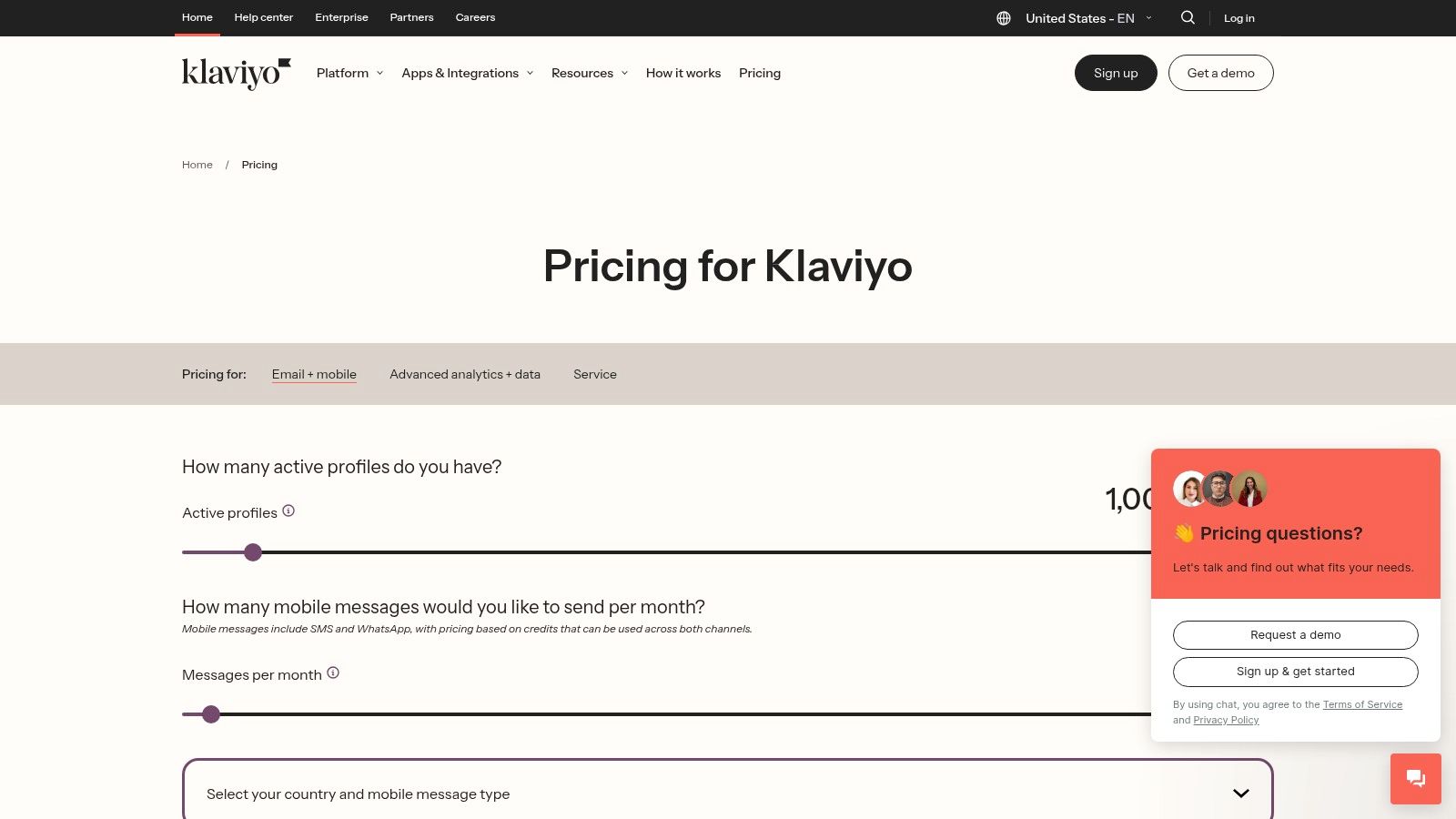
The core strength of Klaviyo is its ability to build complex, automated "flows" based on precise user behavior. Rather than a single-blast email, you can design a journey that adapts to customer actions. For instance, a flow could start with an email, followed by an SMS reminder 24 hours later, and then branch to offer a discount only to first-time customers with a cart value over $100. This level of granularity ensures your messaging is relevant, timely, and effective.
Key Features and Capabilities
Klaviyo's platform is designed for deep data integration, allowing for the creation of truly dynamic and responsive abandonment campaigns that capture shoppers at multiple stages of their journey.
- Pre-built & Customizable Flows: Get started quickly with proven templates for abandoned carts, "Added to Cart," and browse abandonment. These flows can be fully customized with unique branching logic based on cart value, customer history, item categories, and previous engagement.
- Multi-Channel Orchestration: Seamlessly combine email and SMS within a single recovery flow. You can set rules to prioritize channels or use one as a backup if the other is not engaged, creating a persistent but not intrusive follow-up strategy.
- Advanced Segmentation: Leverage deep integrations with platforms like Shopify, BigCommerce, and Magento to create granular segments. Target high-value carts with a special offer or exclude recent purchasers from abandonment messages to avoid message fatigue.
- Benchmarks and Reporting: Klaviyo provides detailed analytics that show revenue recovered per recipient, open rates, click rates, and conversion rates for each step in your flow. It also offers industry benchmarks to see how your performance compares to similar brands.
Pros and Cons
| Deep Personalization & Complex Logic: Unmatched ability to create highly specific and adaptive recovery flows. | Steeper Learning Curve: The range of features can be overwhelming for beginners compared to simpler tools. |
|---|---|
| Broad E-commerce Integrations: Connects seamlessly with major platforms like Shopify, BigCommerce, Magento, and even Buy with Prime. | Scales with Profile Count: Pricing is based on the number of active email and SMS contacts, which can become costly. |
| True Multi-Channel Approach: Natively integrates email and SMS for cohesive communication. | Requires Strategic Management: Maximizing ROI requires a thoughtful approach to segmentation and flow-building. |
Klaviyo is an ideal solution for data-driven brands that have outgrown basic email reminders. Its ability to trigger flows from early-funnel actions like browsing a product page allows businesses to engage potential customers long before they even reach the checkout, making it a comprehensive tool for both preventing and recovering abandoned carts.
Website: https://www.klaviyo.com/pricing
5. Omnisend – Cart & Product Abandonment (Email, SMS, Push)
For e-commerce brands looking to implement a sophisticated, multi-channel recovery strategy without a steep learning curve, Omnisend offers a powerful and accessible solution. It goes beyond simple email reminders by integrating SMS and web push notifications into its pre-built automation workflows. This holistic approach allows businesses to connect with abandoning shoppers on their preferred channels, significantly boosting the chances of conversion and making it one of the most comprehensive shopping cart abandonment solutions available for direct-to-consumer brands.
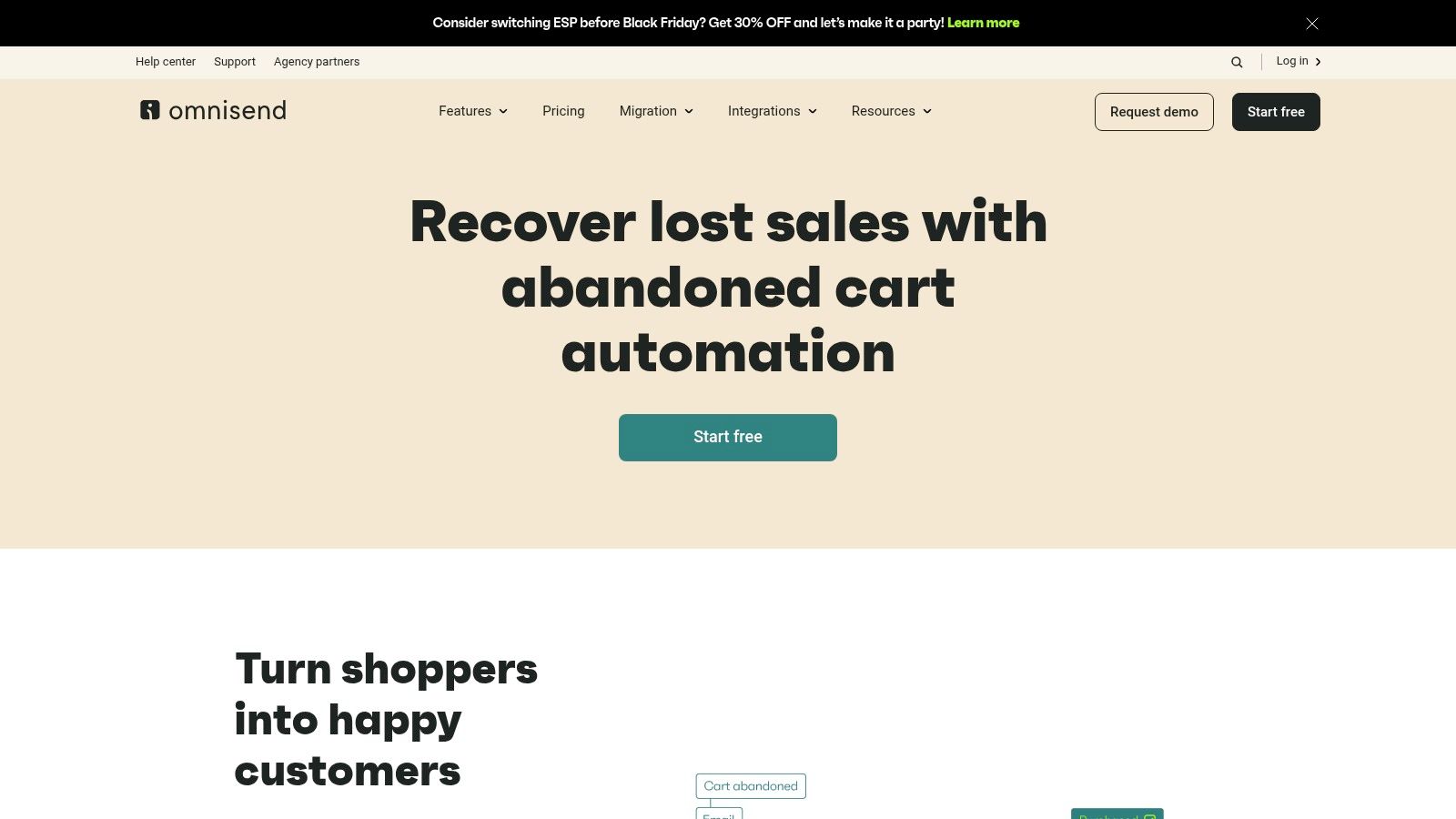
The key advantage of Omnisend is its focus on ease of use combined with powerful e-commerce-centric features. The platform provides ready-made templates for abandoned cart, browse, and product abandonment sequences that users can activate in minutes. These workflows are designed to track not only logged-in users but also anonymous visitors via cookies, expanding the pool of recoverable carts and providing a more complete picture of lost revenue opportunities.
Key Features and Capabilities
Omnisend’s feature set is built to help merchants launch effective, multi-step recovery campaigns quickly while offering the flexibility to customize and segment as their needs evolve. The platform’s strength lies in its unified approach to communication.
- Multi-Channel Workflows: Seamlessly combine email, SMS, and web push notifications within a single automation sequence. You can set conditional logic, such as sending an SMS only if an email hasn't been opened after a certain time.
- Pre-Built Automations: Launch proven cart, product, and browse abandonment sequences with just a few clicks. These templates are based on e-commerce best practices to maximize recovery rates from day one.
- Advanced Segmentation: Target abandoning users based on their cart value, the specific products they left behind, or their overall shopping behavior. This allows for highly personalized and effective messaging.
- Detailed Performance Reports: Track key metrics like open rates, click-through rates, and, most importantly, the exact amount of revenue recovered by each channel and workflow.
Pros and Cons
| Quick to Launch: Pre-built, e-commerce-specific workflows allow for fast implementation. | SMS Costs Can Escalate: Higher messaging volumes will increase costs, requiring careful credit management. |
|---|---|
| True Multi-Channel: Natively combines email, SMS, and push notifications in one platform. | Documentation Can Be Scattered: Some advanced feature details are found in support articles rather than core product pages. |
| Competitive Free Plan: Offers a generous free tier to get started without a credit card commitment. | Interface Can Be Complex: The sheer number of features may be overwhelming for absolute beginners. |
Omnisend is an excellent choice for growing e-commerce stores that have outgrown basic email-only solutions and need a more robust, multi-channel strategy. For a deeper understanding of how these tools fit into a larger strategy, explore these marketing automation best practices. The platform's balance of user-friendly templates and advanced segmentation makes it a scalable tool for recovering lost sales.
Website: https://www.omnisend.com/features/automation/abandoned-cart/
6. OptinMonster – On‑Site Exit‑Intent & Cart Abandonment Prevention
While many tools focus on recovering sales after a shopper leaves, OptinMonster takes a proactive approach by preventing abandonment before it even happens. It specializes in on-site conversion optimization, using its renowned Exit-Intent® technology to engage visitors at the precise moment they are about to leave your checkout or product page. This strategy makes it one of the most effective shopping cart abandonment solutions for businesses wanting to stop lost sales at the source.
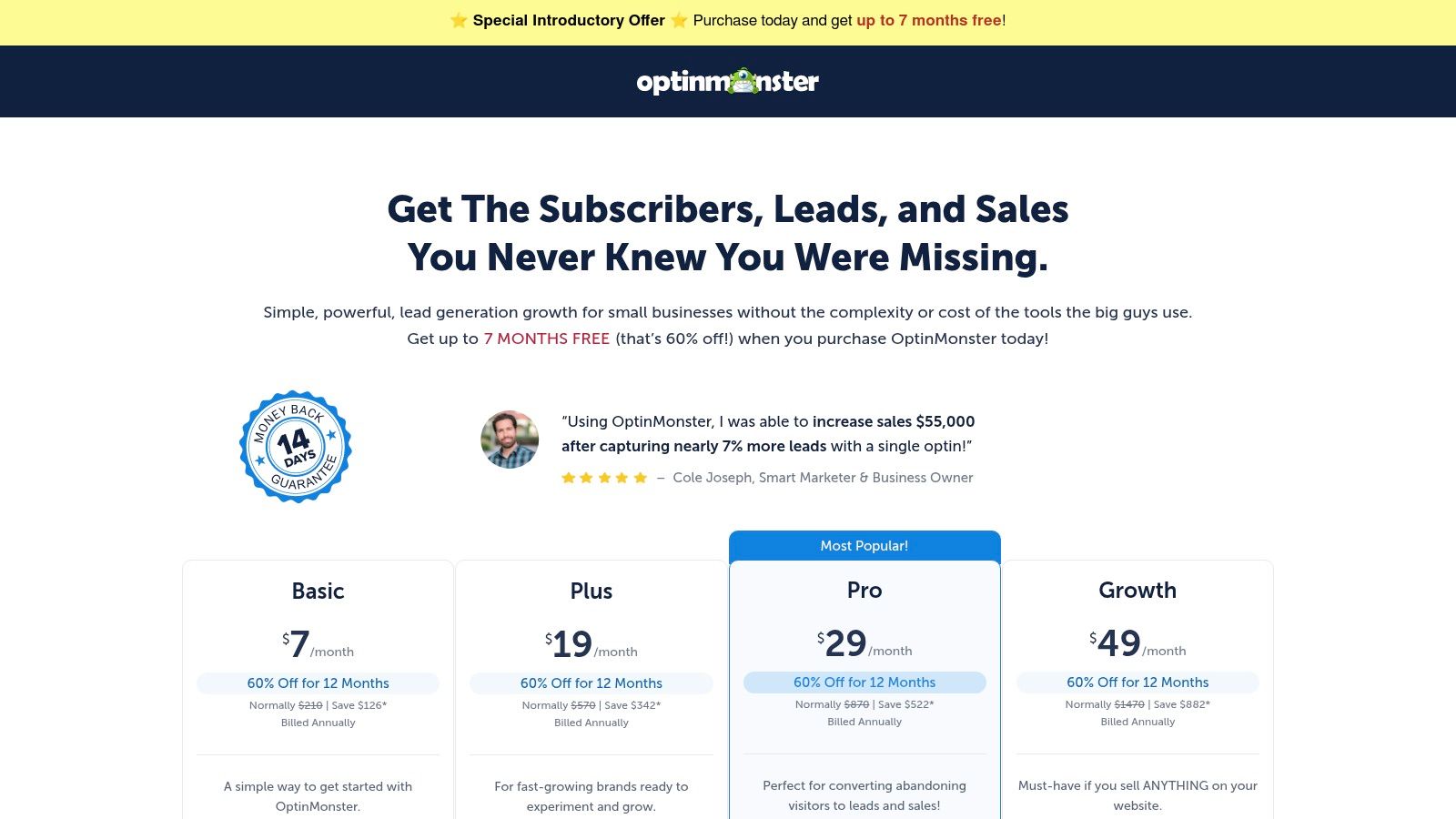
The core strength of OptinMonster is its ability to present a perfectly timed, targeted offer to a hesitant shopper. By tracking mouse movements and user behavior, it can trigger a popup with a special discount, a free shipping offer, or a prompt to save their cart just as they navigate towards the back button or to close the tab. This intervention can be the crucial nudge needed to persuade a customer to complete their purchase immediately.
Key Features and Capabilities
OptinMonster provides a robust suite of tools designed to capture attention and drive on-site conversions. Its focus is on behavior-based targeting, allowing for highly personalized and effective campaigns that feel helpful rather than intrusive.
- Exit-Intent® Technology: Its signature feature detects user intent to leave and displays a targeted campaign. This is ideal for offering last-minute discounts or capturing an email address to save a cart.
- Advanced Targeting Rules: You can create campaigns based on a visitor's location (geo-targeting), the device they are using, the specific page they are on, and whether they are a new or returning visitor.
- A/B Testing and Analytics: Easily test different headlines, offers, and designs to see what converts best. The platform provides clear analytics and revenue attribution to measure the direct impact of your campaigns.
- Seamless Integrations: While it's not an email or SMS service itself, OptinMonster integrates flawlessly with all major email marketing services (like Mailchimp, Klaviyo) and e-commerce platforms (like Shopify, WooCommerce), allowing you to hand off captured leads for automated follow-up sequences.
Pros and Cons
| Excellent On-Site Prevention: Highly effective at reducing abandonment before the user leaves the site. | Requires External Messaging Tools: It is not an all-in-one email/SMS service; integrations are necessary for follow-up. |
|---|---|
| Broad Integrations: Connects with virtually any e-commerce platform and marketing tool. | Key Features on Higher Tiers: Exit-Intent® and other advanced features are not available on the basic plan. |
| Conversion-Optimized Templates: A large library of pre-built templates makes it fast and easy to launch campaigns. | Can Impact Site Speed: Like any script-based tool, improper setup could slightly affect page load times. |
OptinMonster is a powerful choice for e-commerce businesses that want to be proactive about cart abandonment. Its on-site targeting capabilities allow you to address the reasons for abandonment in real-time, often converting a sale that would have otherwise been lost. By integrating it with your preferred email or SMS platform, you can create a comprehensive system that both prevents and recovers abandoned carts.
Website: https://optinmonster.com/pricing
7. CartStack – Dedicated Cart/Browse Abandonment Recovery Suite
For businesses seeking a specialized, laser-focused tool, CartStack offers a powerful suite dedicated entirely to recovering abandoned carts and browsing sessions. Unlike all-in-one marketing platforms, CartStack’s primary mission is to recapture lost revenue through a multi-channel approach. This focus makes it one of the most effective shopping cart abandonment solutions for e-commerce stores that need a high-performance recovery engine that can integrate with any platform.
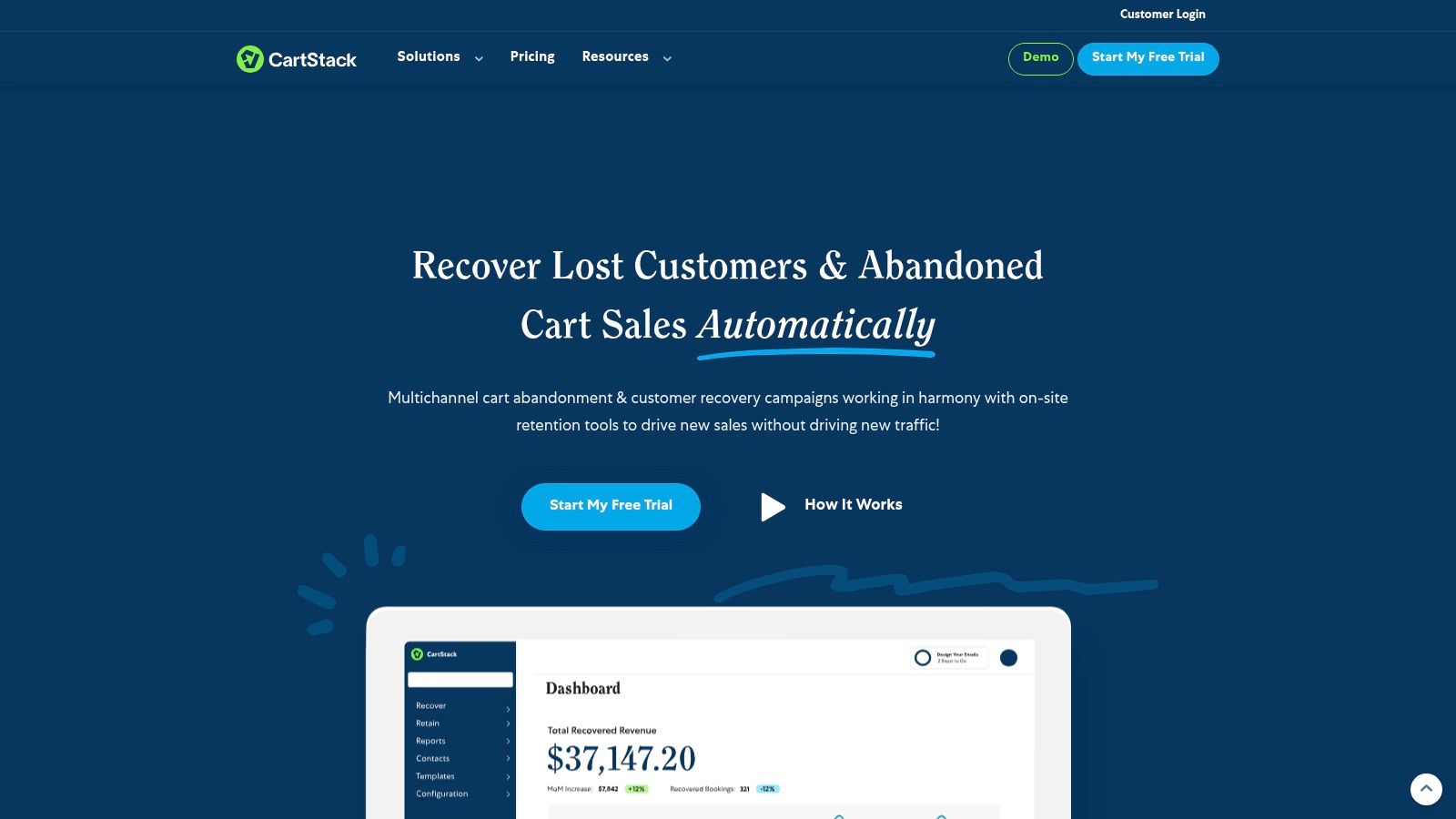
CartStack's strength lies in its platform-agnostic nature and deep feature set for abandonment. By using flexible APIs and JavaScript integrations, it can be deployed on virtually any e-commerce site, from custom-built solutions to popular platforms like Magento or WooCommerce. It goes beyond simple email reminders by incorporating SMS, web push notifications, and on-site conversion tools to create a comprehensive safety net for potential sales.
Key Features and Capabilities
CartStack is engineered to maximize recovery rates by engaging customers across multiple touchpoints at the moment they disengage. Its toolkit is both proactive and reactive, aiming to prevent abandonment before it happens and recover it aggressively when it does.
- Multi-channel Recovery: Deploy automated, personalized campaigns via email, SMS, and web push notifications to reach customers on their preferred channel.
- Exit-Intent Offers: Reduce drop-offs with a conversion toolkit that includes exit-intent popups, on-site messaging, and time-sensitive offers to keep shoppers engaged.
- Flexible Integrations: Its JavaScript and API-based system allows for easy integration with any website, offering a universal solution regardless of your e-commerce platform.
- Agency and Multi-Site Support: Built-in features allow agencies or businesses with multiple stores to manage all their recovery campaigns from a single dashboard, simplifying oversight.
Pros and Cons
| Focused Recovery Suite: Specializes in cart and browse abandonment, leading to high-performance results. | Scalable Pricing: Costs are based on order volume, which can become significant as a business grows. |
|---|---|
| 14-Day Risk-Free Trial: Offers a trial period and optional expert setup assistance to ensure a smooth start. | Niche Focus: Lacks broader email service provider (ESP) features like newsletters or non-abandonment automations. |
| Platform-Agnostic: Works with any e-commerce platform via flexible and robust integrations. | More Complex Setup: May require more technical setup than a native, built-in platform feature. |
CartStack is an ideal choice for businesses that have an existing marketing platform but need a more powerful, dedicated recovery tool to layer on top. The platform’s ability to combine different communication channels into one cohesive strategy is similar to how a business would approach a comprehensive retargeting advertising campaign. For stores looking for a best-in-class, specialized abandonment solution, CartStack delivers robust functionality and measurable ROI.
Website: https://www.cartstack.com/
Top 7 Shopping Cart Abandonment Solutions Comparison
| Life Cycle Marketing | Medium to High - requires agency collaboration and strategic planning | High - full-service team, multi-channel expertise | Comprehensive customer journey growth and retention | Businesses needing integrated, end-to-end digital marketing partner | Holistic approach with 14+ years expertise and continuous optimization |
|---|---|---|---|---|---|
| Shopify – Abandoned Checkout Recovery | Low - built-in features with optional app integrations | Low - native tools, minimal setup | Basic email recovery with multi-channel via apps | Shopify merchants wanting straightforward abandoned checkout recovery | Native integration with clear analytics and easy activation |
| BigCommerce – Abandoned Cart Saver | Low - native email automation, configurable | Low - uses built-in platform features | Automated email recovery with revenue tracking | BigCommerce stores seeking simple, effective cart recovery | No extra integration and actionable reporting |
| Klaviyo – Abandoned Cart Flows | Medium to High - requires setup and customization | Medium to High - depending on profiles and SMS volume | Highly personalized, multi-channel revenue recovery | Brands needing deep segmentation and multi-platform flows | Advanced personalization and broad ecommerce integrations |
| Omnisend – Cart & Product Abandonment | Low to Medium - ready-made workflows | Medium - includes multi-channel messaging | Improved recovery rates with multi-channel reach | DTC brands wanting quick launch and balanced automation | Pre-built workflows, competitive pricing, free starter plan |
| OptinMonster – Exit‑Intent Prevention | Medium - requires integration with messaging tools | Medium - higher-tier plans for key features | Reduced cart abandonment via on-site intervention | Stores focused on proactive onsite abandonment reduction | Strong on-site exit-intent popups with A/B testing |
| CartStack – Cart/Browse Recovery Suite | Medium - platform-agnostic, API integration possible | Medium to High - pricing scales with volume | Multi-channel abandonment recovery and revenue lift | Multi-site/agency users needing flexible, focused recovery suite | Flexible multi-channel platform with expert assistance available |
Choosing Your Path to Fewer Abandoned Carts
Tackling the challenge of cart abandonment isn't about finding a single, magical fix. It's about building a strategic, multi-layered system designed to understand customer hesitation and gently guide them back to completing their purchase. Throughout this guide, we've explored a powerful spectrum of shopping cart abandonment solutions, each offering a unique approach to recovering lost revenue.
From the accessible, built-in recovery tools offered by e-commerce giants like Shopify and BigCommerce to the sophisticated, multi-channel automation of dedicated platforms like Klaviyo and Omnisend, the options are vast. We've seen how proactive, on-site tools like OptinMonster can prevent abandonment before it even happens, while specialized recovery suites like CartStack offer a laser-focused approach to bringing shoppers back.
Your Roadmap to Choosing the Right Solution
Selecting the perfect toolset depends on a clear-eyed assessment of your business's unique circumstances. There is no one-size-fits-all answer, but by considering a few key factors, you can make an informed decision that drives real results.
Here are the essential questions to ask yourself:
- What is your current tech stack? If you're on Shopify or BigCommerce, starting with their native tools is a logical and cost-effective first step. For more complex needs, ensure your chosen solution integrates seamlessly with your platform.
- Where are your customers engaging? If your audience is highly active on SMS, a tool like Klaviyo or Omnisend that excels at multi-channel communication is critical. If your focus is purely on-site prevention, OptinMonster might be your best bet.
- What is your budget? Solutions range from included platform features to comprehensive subscription-based services. Define your budget upfront, but also consider the potential return on investment that a more powerful tool can deliver.
- How much technical expertise do you have? Some tools are virtually plug-and-play, while others require more a more in-depth setup to unlock their full potential. Be realistic about the time and resources you can dedicate to implementation and ongoing management.
From Tools to a Holistic Strategy
Implementing any of these tools will undoubtedly move the needle. However, the most successful brands understand that cart recovery is just one piece of a much larger puzzle. It's a critical component of a comprehensive Life Cycle Marketing strategy that nurtures the customer relationship from initial awareness to post-purchase loyalty and beyond.
The goal is not just to recover a single sale but to understand why the cart was abandoned in the first place. Was it an unexpected shipping cost? A confusing checkout process? A moment of distraction? Analyzing this data provides invaluable feedback for optimizing your entire customer experience. Ultimately, all shopping cart abandonment solutions are geared towards one goal: applying effective strategies to improve website conversion rates by turning browsing into buying.
By thoughtfully selecting and implementing the right tools, you can transform abandoned carts from a frustrating metric into a powerful opportunity for re-engagement and revenue growth. Start with one solution, measure its impact, learn from the data, and build from there. Your bottom line will thank you for it.
Ready to move beyond individual tools and implement a holistic strategy that turns abandoned carts into loyal customers? The team at Rebus specializes in building comprehensive Life Cycle Marketing systems that integrate advanced recovery tactics into your entire customer journey. Schedule a consultation with Rebus today to discover how a fully managed approach can maximize your revenue and fuel sustainable growth.
